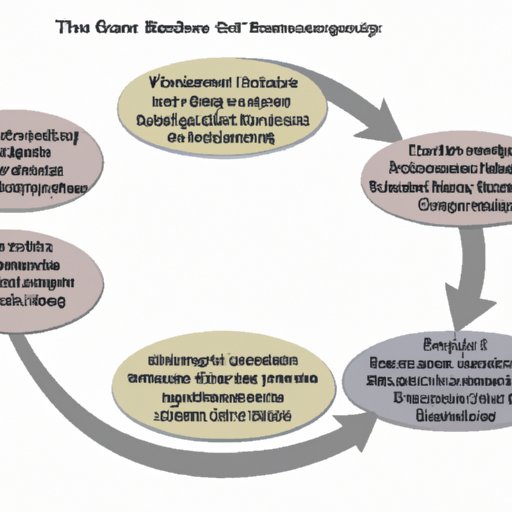
An Overview of the Financial Cycle: Exploring What It Is and How It Works
The financial cycle is a cyclical process that impacts businesses, consumers, and investors. It is comprised of different phases that can be loosely categorized as expansion, recession, and recovery. Understanding the financial cycle can help businesses, consumers, and investors make better decisions by anticipating changes in the market.
Definition of the Financial Cycle
According to the Federal Reserve Bank of San Francisco, the financial cycle “refers to the cyclical ups and downs in economic activity over time, including fluctuations in economic output, employment, prices, and credit conditions.” In other words, the financial cycle is the regular pattern of economic growth and contraction that occurs over time.
Components of the Financial Cycle
The financial cycle is made up of three main components: expansion, recession, and recovery. During the expansion phase, economic activity increases and unemployment rates decline. This is typically accompanied by an increase in consumer spending, investment, and production. During the recession phase, economic activity slows down, unemployment rates rise, and consumer spending and investment decrease. Lastly, during the recovery phase, economic activity begins to pick up again, unemployment begins to fall, and consumer spending and investment start to increase.
The Role of Central Banks in the Financial Cycle
Central banks play a key role in managing the financial cycle. They have tools such as monetary policy, which they can use to influence the economy by controlling the supply of money in circulation. By manipulating interest rates, they can encourage or discourage borrowing, which in turn can impact economic growth. For example, if the central bank raises interest rates, it will cost more to borrow money, which can lead to slower economic growth. On the other hand, if the central bank lowers interest rates, it will become cheaper to borrow money, which can lead to faster economic growth.
How to Navigate the Financial Cycle: Tips for Making Smart Decisions
Navigating the financial cycle can be challenging, but there are some tips that can help you make smarter decisions.
Analyzing the Different Phases of the Financial Cycle
The first step in navigating the financial cycle is to analyze the different phases. Keeping track of economic indicators such as GDP, inflation rates, and unemployment rates can provide insight into the current state of the economy. Paying attention to news reports and government policies can also help you stay informed about potential changes in the financial cycle.
Understanding the Interconnectedness of the Global Financial Cycle
It is important to understand that the financial cycle is interconnected with the global economy. Events in one country can have a ripple effect on the economies of other countries. For example, the 2008 financial crisis was caused in part by the collapse of the U.S. housing market, but it had a global impact. Therefore, it is important to be aware of global economic events and their potential impacts on the financial cycle.
Examining the Impact of Political and Economic Events on the Financial Cycle
Political and economic events can also have an impact on the financial cycle. For example, the election of a new government can cause shifts in economic policy, which can have an impact on the financial cycle. Similarly, natural disasters, wars, and other unexpected events can have a significant impact on the financial cycle. Therefore, it is important to pay attention to these events and their potential impacts.
The Impact of the Financial Cycle on Businesses, Consumers, and Investors
The financial cycle can have a significant impact on businesses, consumers, and investors. Understanding the financial cycle can help them make better decisions and prepare for potential changes in the market.
How Businesses Can Use the Financial Cycle to Their Advantage
Businesses can use the financial cycle to their advantage by using it to anticipate changes in the market. By understanding the different phases of the financial cycle, businesses can prepare for potential downturns or upturns in the economy. For example, during an expansion phase, businesses can invest in new equipment or hire additional staff to take advantage of the increased demand. Conversely, during a recession phase, businesses can reduce costs by cutting back on capital investments or reducing staff.
How Consumers Can Use the Financial Cycle to Make Smart Financial Decisions
Consumers can use the financial cycle to make smart financial decisions. During an expansion phase, consumers may want to consider taking out a loan or investing in stocks and bonds. During a recession phase, however, consumers may want to consider saving more money or paying off debt. Additionally, consumers should pay attention to changes in interest rates as this can impact their ability to borrow money.
How Investors Can Use the Financial Cycle to Make Informed Investment Decisions
Investors can use the financial cycle to make informed investment decisions. During an expansion phase, investors may want to consider investing in stocks or real estate. During a recession phase, however, investors may want to consider investing in bonds or gold. Additionally, investors should pay close attention to changes in interest rates as this can have an impact on their investments.

Exploring the Benefits of Understanding the Financial Cycle
Understanding the financial cycle can offer numerous benefits to businesses, consumers, and investors.
Improved Risk Management
By understanding the financial cycle, businesses, consumers, and investors can better manage risk. By anticipating changes in the market, they can adjust their strategies accordingly and minimize potential losses or maximize potential gains. For example, businesses can use the financial cycle to adjust their pricing strategies, while investors can use it to decide when to buy or sell investments.
Increased Financial Stability
Understanding the financial cycle can also help businesses, consumers, and investors achieve greater financial stability. By anticipating changes in the market, they can plan for potential downturns or upturns and ensure that they have enough cash reserves to weather any storm. Additionally, understanding the financial cycle can help businesses, consumers, and investors make more informed decisions, which can lead to greater financial stability.
Enhanced Economic Growth
Finally, understanding the financial cycle can help to promote economic growth. By anticipating changes in the market, businesses can adjust their strategies accordingly and take advantage of potential opportunities. Likewise, consumers can use the financial cycle to make informed decisions that can help them build wealth and achieve financial security. Similarly, investors can use the financial cycle to make informed decisions that can result in higher returns.
Conclusion
The financial cycle is a cyclical process that impacts businesses, consumers, and investors. Understanding the financial cycle can help businesses, consumers, and investors make better decisions by anticipating changes in the market. Additionally, understanding the financial cycle can offer numerous benefits such as improved risk management, increased financial stability, and enhanced economic growth.
(Note: Is this article not meeting your expectations? Do you have knowledge or insights to share? Unlock new opportunities and expand your reach by joining our authors team. Click Registration to join us and share your expertise with our readers.)
